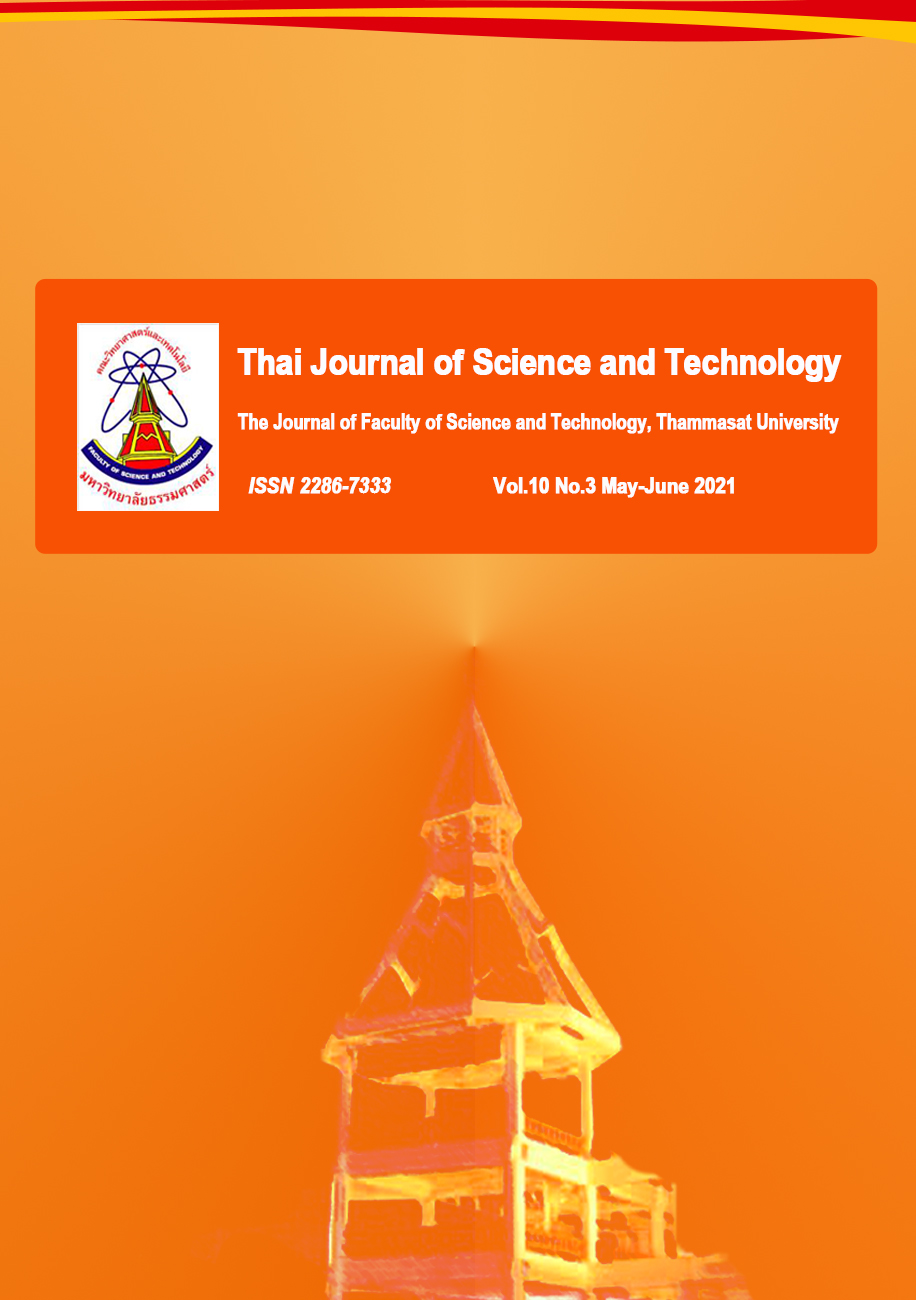Enzymatic Hydrolysis of Cricket (Gryllodes sigillatus) Protein: Influence of Alcalase and Neutrase Enzyme on Functional Properties of Recovered Protein
Main Article Content
Abstract
This study investigated the effects of enzyme concentration and hydrolysis time on improving the functional properties of cricket protein. The goal was to develop alternative sustainable protein from insects. Cricket protein was hydrolyzed using two proteolytic enzymes: Neutrase 0.8L and Alcalase 2.4L. We tested enzyme concentrations of 1.5 and 3.0%(w/w), and exposure times of 45 and 90 min. For both enzymes, the percentage yield increased as the enzyme concentration and hydrolysis time increased. The protein content of Neutrase-produced hydrolysate was higher (>80%) than that of Alcalase-produced hydrolysate (>70%). The highest degree of hydrolysis (DH) was 38.8% for Alcalase (at 3.0%, 90 min) and 70.2% for Neutrase (at 3.0%, 90 min). Both were higher than control (17.8% at 90 min). Hydrolysis by both enzymes improved the solubility of cricket protein hydrolysates over a range of pH values, exhibiting >56% soluble protein at pH 3 and >90% at pH 7 and 8. The hydrolysates had good foaming capacity (36.56% and 28.23%) and emulsification properties (44.03% and 44.47%). Emulsion stability and foaming stability were greatly high, exceeding 96% and 97.96%. These improvements in the functional properties of cricket protein hydrolysates give them potential uses in a range of food products.
Article Details

This work is licensed under a Creative Commons Attribution-NonCommercial-NoDerivatives 4.0 International License.
บทความที่ได้รับการตีพิมพ์เป็นลิขสิทธิ์ของคณะวิทยาศาสตร์และเทคโนโลยี มหาวิทยาลัยธรรมศาสตร์ ข้อความที่ปรากฏในแต่ละเรื่องของวารสารเล่มนี้เป็นเพียงความเห็นส่วนตัวของผู้เขียน ไม่มีความเกี่ยวข้องกับคณะวิทยาศาสตร์และเทคโนโลยี หรือคณาจารย์ท่านอื่นในมหาวิทยาลัยธรรมศาสตร์ ผู้เขียนต้องยืนยันว่าความรับผิดชอบต่อทุกข้อความที่นำเสนอไว้ในบทความของตน หากมีข้อผิดพลาดหรือความไม่ถูกต้องใด ๆ
References
แก้ไขชื่อเรื่อง (ชื่อวิทย์ ตัวเอียง)
Enzymatic Hydrolysis of Cricket (Gryllodes sigillatus) Protein: Influence of Alcalase and Neutrase Enzyme on Functional Properties of Recovered Protein
แก้ไขอ้างอิง
Adler-Nissen, J. (1986). Enzymatic hydrolysis of food proteins (1st Ed.). London: Elsevier applied science publishers.
Aluko, R.E. (2018). Food protein-derived peptides: Production, isolation, and purification. In Proteins in Food Processing (pp. 389-412). Cambridge: Woodhead Publishing.
Blásquez, J., Moreno, J., & Camacho, V. (2012). Could grasshoppers be a nutritive meal? Food and Nutrition Science, 3(2), 164-175.
Chalamaiah, M., Hemalatha, R., & Jyothirmayi, T. (2012). Fish protein hydrolysates: Proximate composition, amino acid composition, antioxidant activities and applications. Food Chemistry, 135(4), 3020-3038.
Chalamaiah, M., Rao, G.N., Rao, D.G., & Jyothirmayi, T. (2010). Protein hydrolysates from meriga (Cirrhinus mrigala) egg and evaluation of their functional properties. Food Chemistry, 120(3), 652-657.
Chi, E.Y., Krishnan, S., Randolph, T.W., & Carpenter, J.F. (2003). Physical stability of proteins in aqueous solution: Mechanism and driving forces in nonnative protein aggregation. Pharmaceutical Research, 20(9), 1325-1336.
Chobert, J.M., Bertrand-Harb, C., & Nicolas, M.G. (1988). Solubility and emulsifying properties of caseins and whey proteins modified enzymically by trypsin. Journal of Agricultural and Food Chemistry, 36(5), 883-892.
Hall, F.G., Jones, O.G., O'Haire, M.E., & Liceaga, A.M. (2017). Functional properties of tropical banded cricket (Gryllodes sigillatus) protein hydrolysates. Food Chemistry, 224, 414-422.
Halling, P.J. (1981). Protein stabilized foams and emulsions. Critical Reviews in Food Science and Nutrition, 12, 155–203.
Hartmann, C., Shi, J., Giusto, A., & Siegrist, M. (2015). The psychology of eating insects: A cross-cultural comparison between Germany and China. Food Quality and Preference, 44, 148-156.
Huis, A., Itterbeeck, J., Klunder, H., Mertens, E., Halloran, A., Muir, G., & Vantomme, P. (2013). Edible insects: Future prospects for food and feed security. FAO Forestry Papers, 171.
Khaled, H.B., Ktari, N., Ghorbel-Bellaaj, O., Jridi, M., Lassoued, I., & Nasri, M. (2014). Composition, functional properties and in vitro antioxidant activity of protein hydrolysates prepared from sardinelle (Sardinella aurita) muscle. Journal of Food Science and Technology, 51(4), 622-633.
Kristinsson, H.G., & Rasco, B.A. (2000). Fish protein hydrolysates: Production, biochemical, and functional properties. Critical Reviews in Food Science and Nutrition, 40(1), 43-81.
Li-Chan, E., & Nakai, S. (1991). Importance of hydrophobicity of proteins in food emulsions. In Microemulsions and Emulsions in Foods (pp. 193-212). Washington: American Chemical Society.
Mwangi, M.N., Oonincx, D.G.A.B., Stouten, T., Veenenbos, M., Melse-Boonstra, A., Dicke, M., & van Loon, J.J.A. (2018). Insects as sources of iron and zinc in human nutrition. Nutrition Research Reviews, 31, 248–255.
Purschke, B., Meinlschmidt, P., Horn, C., Rieder, O., & Jäger, H. (2018). Improvement of techno-functional properties of edible insect protein from migratory locust by enzymatic hydrolysis. European Food Research and Technology, 244, 999–1013.
Rumpold, B., & Schlüter, O. (2013). Nutritional composition and safety aspects of edible insects. Molecular Nutrition & Food Research, 57(5), 802-823.
Sanchez, C.C., & Patio, J.M.R. (2005). Interfacial, foaming, and emulsifying characteristics of sodium caseinate as influenced by protein concentration in solution. Food Hydrocolloids, 19, 407–416.
Sirimungkararat, S., Saksirirat, W., Nopparat, T., & Natongkham, A. (2008). Edible products from eri and mulberry silkworms in Thailand. In Forest insects as food: Humans bite back. Proceedings of a workshop on Asia-Pacific resources and their potential for development, Chiang Mai, Thailand.
Tan, H.S.G., Fischer, A.R.H., Trijp, H.C.M., & Stieger, M. (2016). Tasty but nasty? Exploring the role of sensory-liking and food appropriateness in the willingness to eat unusual novel foods like insects. Food Quality and Preference, 48, 293-302.
Waniska, R.D., & Kinsella, J.E. (1979). Foaming properties of proteins: Evaluation of a column aeration apparatus using ovalbumin. Journal of Food Science, 44(5), 1398-1402.
Wu, H., Wang, Q., Ma, T., & Ren, J. (2009). Comparative studies on the functional properties of various protein concentrate preparations of peanut protein. Food Research International, 42(3), 343-348.
Zhang, H.J., Zhang, H., Wang, L., & Guo, X.N. (2012). Preparation and functional properties of rice bran proteins from heat-stabilized defatted rice bran. Food Research International, 47(2), 359-363.
Zhao, Q., Xiong, H., Selomulya, C., Chen, X.D., Zhong, H., Wang, S., Sun, W., & Zhou, Q. (2012). Enzymatic hydrolysis of rice dreg protein: Effects of enzyme type on the functional properties and antioxidant activities of recovered proteins. Food Chemistry, 134(3), 1360-1367.


